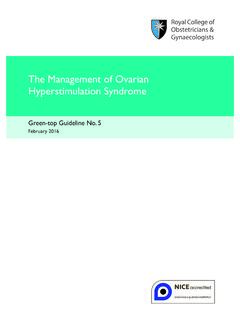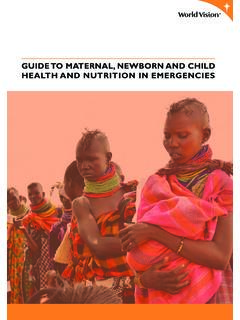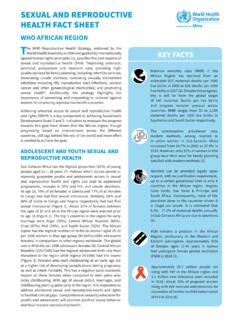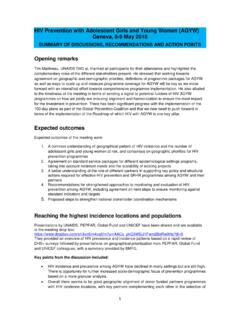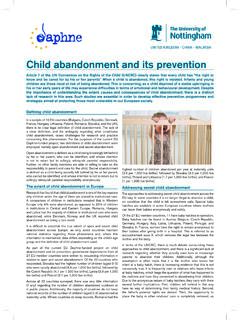Transcription of Management of Sickle Cell Disease in Pregnancy
1 Management of Sickle Cell Disease in Pregnancy Green top Guideline No. 61. July 2011. Management of Sickle Cell Disease in Pregnancy This is the first edition of this guideline. 1. Purpose and scope The purpose of this guideline is to describe the Management of pregnant women with Sickle cell Disease (SCD). It will include preconceptual screening and antenatal, intrapartum and postnatal Management . It will not cover the Management of women with Sickle cell trait. 2. Background and introduction SCD is a group of inherited single-gene autosomal recessive disorders caused by the Sickle ' gene, which affects haemoglobin SCD has its origins in sub-Saharan Africa and the Middle East,2,3 hence it is most prevalent in individuals of African descent as well as in the Caribbean, Middle East, parts of India and the Mediterranean, and South and Central America.
2 Owing to population migration, SCD is now of increasing importance worldwide and there are increasing numbers of affected individuals in Europe and the 7. The term SCD includes Sickle cell anaemia (HbSS) and the heterozygous conditions of haemoglobin S and other clinically abnormal include combination with haemoglobin C (giving HbSC), combination with beta thalassaemia (giving HbSB thalassaemia) and combination with haemoglobin D, E or O-Arab. All of these genotypes will give a similar clinical phenotype of varying Haemoglobin S combined with normal haemoglobin (A), known as Sickle trait (AS), is asymptomatic, except for a possible increased risk of urinary tract infections and microscopic haematuria, and is not considered further in this guideline.
3 SCD is the most common inherited condition worldwide. About 300 000 children with SCD are born each year;8,9 two-thirds of these births are in In the UK, it is estimated that there are 12 000 15 000 affected individuals and over 300 infants born with SCD in the UK each year who are diagnosed as part of the neonatal screening There are approximately 100 200 pregnancies in women with SCD per year in the UK; Pregnancy outcome in this group is currently being assessed by the UK Obstetric Surveillance System [ ]. The pathophysiology of SCD is a consequence of polymerisation of the abnormal haemoglobin in low-oxygen conditions, which leads to the formation of rigid and fragile Sickle -shaped red cells.
4 These cells are prone to increased breakdown, which causes the haemolytic anaemia, and to vaso-occlusion in the small blood vessels, which causes most of the other clinical features, including acute painful crises. Other complications of SCD. include stroke, pulmonary hypertension, renal dysfunction, retinal Disease , leg ulcers, cholelithiasis and avascular necrosis (which commonly affects the femoral head and may necessitate hip replacement). SCD was previously associated with a high early mortality rate, but now the majority of children born with SCD in the UK live to reproductive age and average life expectancy is at least the ,12. 3. Identification and assessment of evidence This RCOG guideline was developed in accordance with standard methodology for producing RCOG Green- top 15 Medline, Embase, the Cochrane Database of Systematic Reviews, the Cochrane Control Register of Controlled Trials (CONTROL), the Database of Abstracts of Reviews and Effects (DARE), the ACP.
5 Journal Club and the Ovid database were searched for relevant randomised controlled trials, systematic reviews and meta-analyses between 1980 and August 2009. Search terms included: Sickle cell', hydroxycarbamide', antenatal', Pregnancy ', intrapartum', penicillin prophylaxis', ACE inhibitor', transfusion', ultrasound', Doppler', echocardiogram', anticoagulation', prophylaxis', Sickle cell and risk factors', preconceptual' and Sickle cell crisis' and included all relevant MeSH terms and search was limited to humans and RCOG Green-top Guideline No. 61 2 of 20 Royal College of Obstetricians and Gynaecologists the English language. The National Library for Health and the National Guidelines Clearing House were also searched for relevant guidelines.
6 Where possible, recommendations are based on available evidence; areas where evidence is lacking are annotated as good practice points (designated by a tick). 4. Preconception care What are the additional risks to the woman and baby? SCD is associated with both maternal and fetal complications and is associated with an increased incidence of perinatal mortality,16 21 premature labour,16 22 fetal growth restriction16 23 and acute painful crises during 19,24,25 Some studies also describe an increase in spontaneous miscarriage,22 antenatal hospitalisation,23 maternal mortality,26 delivery by caesarean section,23,26 infection, thromboembolic events27. and antepartum An increased risk of pre-eclampsia and Pregnancy -induced hypertension has been described in some studies16,18,19,23,26 but not in ,20,22 In HbSC there are fewer reported adverse outcomes, but there is evidence of an increased incidence of painful crises during Pregnancy ,28 fetal growth restriction, antepartum hospital admission and postpartum What is the importance of planning Pregnancy and how can outcomes for the woman and baby be improved?
7 From adolescence, the intentions of women with SCD regarding Pregnancy and contraception should be D. documented at each contact with their Sickle care team. Women with SCD should be seen preconceptually by a Sickle specialist to receive information about how SCD affects Pregnancy and how Pregnancy affects Sickle cell Disease , and how to improve outcomes for D. mother and baby. This consultation should include optimisation of Management and screening for end organ damage. Primary care physicians have a key role in preconceptual screening, including the provision of contraceptive advice. Women with SCD should receive not only the general preconceptual care which is P. given to all women but also additional advice about vaccinations, medications and crisis avoidance.
8 Advise women to have a low threshold for seeking medical help. P. Reproductive planning and contraceptive choice should be part of the regular outpatient consultation in the Sickle cell clinic. SCD is a chronic, lifelong condition and there are recommendations for clinical care which apply to all patients, including women planning to become Women should be reviewed at least annually by a specialist Sickle service for the monitoring of chronic Disease complications and the imparting of Information that is particularly relevant for women planning to conceive includes: the role of dehydration, cold, hypoxia, overexertion and stress in the frequency of Sickle cell crises how nausea and vomiting in Pregnancy can result in dehydration and the precipitation of crises the risk of worsening anaemia, the increased risk of crises and acute chest syndrome (ACS) and Evidence the risk of increased infection (especially urinary tract infection) during Pregnancy level 4.
9 The increased risk of having a growth-restricted baby, which increases the likelihood of fetal distress, induction of labour and caesarean section16,17,18,22,23. the chance of their baby being affected by SCD. an up-to-date assessment for chronic Disease complications. RCOG Green-top Guideline No. 61 3 of 20 Royal College of Obstetricians and Gynaecologists The assessment for chronic Disease complications should include: Screening for pulmonary hypertension with echocardiography. The incidence of pulmonary hypertension is increased in patients with SCD and is associated with increased A. tricuspid regurgitant jet velocity of more than m/second is associated with a high risk of pulmonary Screening should be performed if this has not been carried out in the last Blood pressure and urinalysis should be performed to identify women with hypertension and/or proteinuria.
10 Renal and liver function tests should be performed annually to identify Sickle nephropathy and/or deranged hepatic Retinal screening. Proliferative retinopathy is common in patients with SCD, especially patients Evidence with HbSC, and can lead to loss of There is no randomised evidence on whether routine level 4. screening should be performed or if patients should be screened only if they experience visual symptoms, but we recommend that women are screened preconceptually. Screening for iron overload. In women who have been multiply transfused in the past or who have a high ferritin level, T2* cardiac magnetic resonance imaging may be helpful to assess body iron loading.
